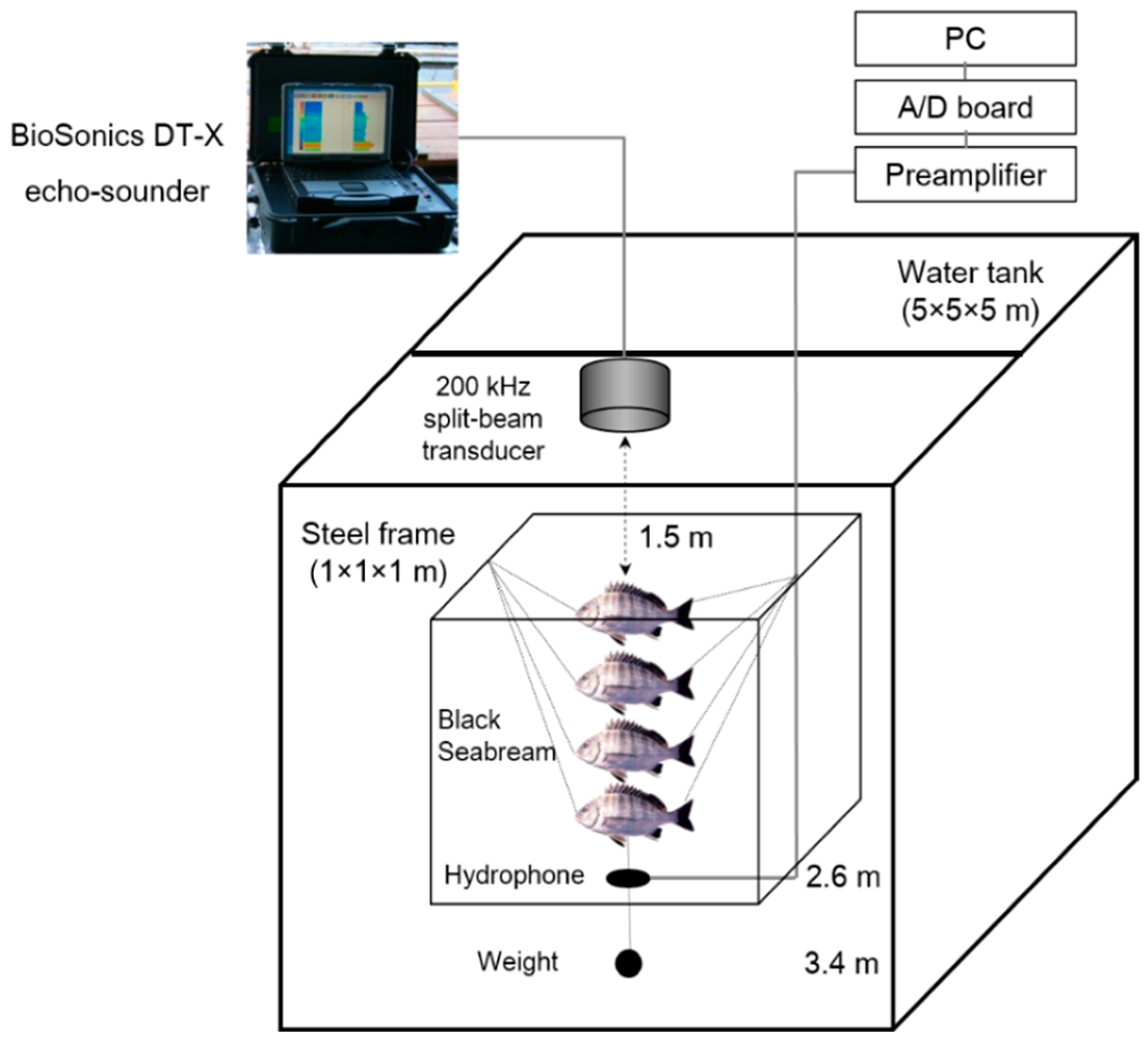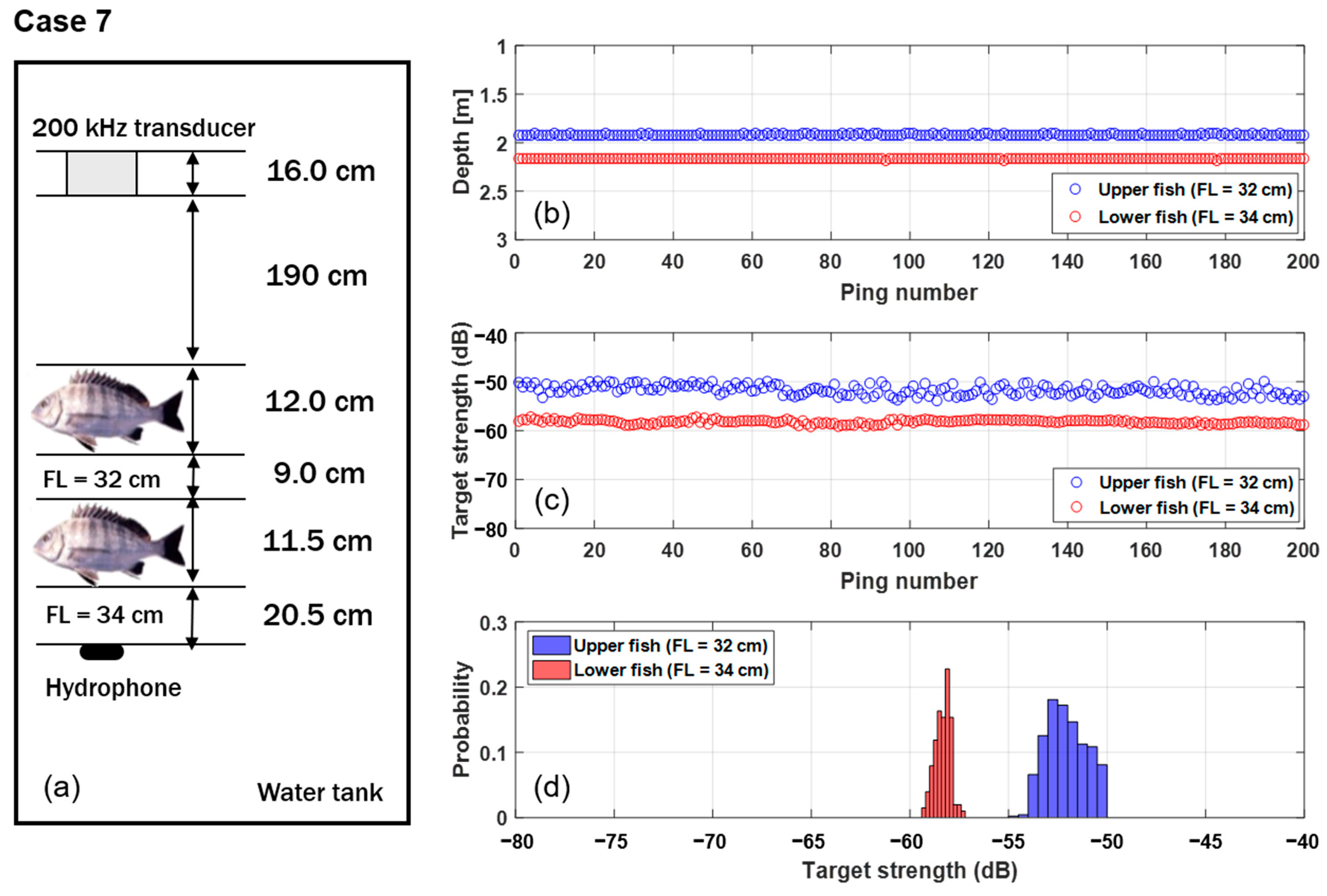Characteristics of Sound Attenuation by Individual and Multiple Fishes
Abstract
1. Introduction
2. Materials and Methods
2.1. Attenuation Coefficient
2.2. Experimental Apparatus
2.3. Attenuation Measurement and Signal Processing
3. Results
4. Discussion
5. Conclusions
Author Contributions
Funding
Institutional Review Board Statement
Informed Consent Statement
Data Availability Statement
Acknowledgments
Conflicts of Interest
References
- Simmonds, E.J.; MacLennan, D.N. Fisheries Acoustics: Theory and Practice, 2nd ed.; Blackwell Science: Oxford, UK, 2005; pp. 1–437. ISBN 9780632059942. [Google Scholar]
- Kim, H.; Kang, D.; Cho, S.; Kim, M.; Park, J.; Kim, K. Acoustic target strength measurements for biomass estimation of aquaculture fish, Redlip mullet (Chelon haematocheilus). Appl. Sci. 2018, 8, 1536. [Google Scholar] [CrossRef]
- Hewitt, R.P.; Demer, D.A. Dispersion and abundance of Antarctic krill in the vicinity of Elephant Island in the 1992 austral summer. Mar. Ecol. Prog. Ser. 1993, 99, 29–39. [Google Scholar] [CrossRef]
- Toresen, R. Absorption of acoustic energy in dense herring schools studies by the attenuation in the bottom echo signal. Fish. Res. 1991, 10, 317–327. [Google Scholar] [CrossRef]
- Raveau, M.; Feuillade, C. Sound extinction by fish schools: Forward scattering theory and data analysis. J. Acoust. Soc. Am. 2015, 137, 539–555. [Google Scholar] [CrossRef]
- Duane, D.; Cho, B.; Jain, A.D.; Godo, O.R.; Makris, N.C. The effect of attenuation from fish shoals on long-range, wide-area acoustic sensing in the ocean. Remote Sens. 2019, 11, 2464–2487. [Google Scholar] [CrossRef]
- Foote, K.G. Extinction cross-section of Norwegian spring-spawning herring. ICES J. Mar. Sci. 1999, 56, 606–612. [Google Scholar] [CrossRef]
- Foote, K.G. Linearity of fisheries acoustics, with addition theorems. J. Acoust. Soc. Am. 1983, 73, 1932–1940. [Google Scholar] [CrossRef]
- Bjerkeng, B.; Borgstrøm, R.; Brabrand, Å.; Faafeng, B. Fish size distribution and total fish biomass estimated by hydroacoustical methods: A statistical approach. Fish. Res. 1991, 11, 41–73. [Google Scholar] [CrossRef]
- Godlewska, M.; Colon, M.; Jóźwik, A.; Guillard, J. How pulse lengths impact fish stock estimations during hydroacoustic measurements at 70 kHz. Aquat. Living Resour. 2011, 24, 71–78. [Google Scholar] [CrossRef]
- Idczak, J.; Gorska, N.; Arciszewski, B. Study of swimbladder morphometry of baltic herring and sprat (development of measurement methodology). Hydroacoustics 2011, 14, 61–68. [Google Scholar]
- Rodríguez-Sánchez, V.; Encina-Encina, L.; Rodríguez-Ruiz, A.; Sánchez-Carmona, R. Do close range measurements affect the target strength (TS) of fish in horizontal beaming hydroacoustics? Fish. Res. 2016, 173, 4–10. [Google Scholar] [CrossRef]
- Ding, L. Direct laboratory measurement of forward scattering by individual fish. J. Acoust. Soc. Am. 1996, 101, 3398–3404. [Google Scholar] [CrossRef]
- Ding, L.; Takao, Y.; Sawada, K.; Okumura, T.; Miyanohana, Y.; Furusawa, M.; Farmer, D.M. Laboratory measurement of forward and bistatic scattering of fish at multiple frequencies. J. Acoust. Soc. Am. 1998, 103, 3241–3244. [Google Scholar] [CrossRef]
- Hashimoto, T. Characteristics of ultrasonic waves transmitted horizontally in the water. Rep. Fish. Boat Lab. 1955, 2, 55–58. (In Japanese) [Google Scholar]
- Ishii, K.; Furusawa, M.; Miyanohana, Y. Measurements of attenuation of sound by schooling fish (young yellowtail and red sea bream). Tech. Rep. Nat. Res. Inst. Fish. Eng. 1983, 4, 73–94. (In Japanese) [Google Scholar]
- Davies, I.E. Attenuation of sound by schooled anchovies. J. Acoust. Soc. Am. 1973, 54, 213–217. [Google Scholar] [CrossRef]
- Ishii, K.; Furusawa, M.; Miyanohana, Y. Measurement of attenuation of sound by schooling fish. In Proceedings of the Acoustical Society of Japan, Tokyo, Japan, 1 March 1985; pp. 715–716. (In Japanese). [Google Scholar]
- Kim, H.; Paeng, D.G. In situ measurement of sound attenuation by fish schools (Japanese Horse Mackerel, Trachurus japonicus) at Mid-Frequency Bands. Appl. Sci. 2021, 11, 1944. [Google Scholar] [CrossRef]
- Foote, K.G. Analysis of empirical observations on the scattering of sound by encaged aggregations of fish. Fiskeridir. Skr. Ser. Havunders. 1978, 16, 422–455. [Google Scholar]
- Burczynski, J.J.; Johnson, R.L.; Kreiberg, H.; Kirchner, W.B. Acoustic estimation of dense aggregation of fish in sea pens. Rapports et Procès-Verbaux des Réunions du Conseil International pour l’Exploration de la Mer 1990, 189, 54–64. [Google Scholar]
- Furusawa, M.; Ishii, K.; Miyanohana, Y. Attenuation of sound by schooling fish. J. Acoust. Soc. Am. 1992, 92, 987–994. [Google Scholar] [CrossRef]
- Diachok, O.; Wales, S. Concurrent inversion of geo- and bio-acoustic parameters from transmission loss measurements in the Yellow Sea. J. Acoust. Soc. Am. 2005, 117, 1965–1976. [Google Scholar] [CrossRef]
- Medwin, H.; Clay, C.S. Fundamentals of Acoustical Oceanography; Academic Press: Boston, USA, 1997; pp. 1–712. ISBN 9780124875708. [Google Scholar]
- Born, M.; Wolf, E. Principles of Optics, 4th ed.; Pergamon Press: Oxford, UK, 1970; pp. 1–808. ISBN 9780521642224. [Google Scholar]
- Dolder, C. Direct Measurement of Effective Medium Properties of Model Fish School. Ph.D. Thesis, The University of Texas at Austin, Austin, TX, USA, 2014. [Google Scholar]
- Raveau, M. A review of theoretical models for attenuation of sound by bubble clouds. In Proceedings of the 22nd International Conference on Acoustics, Buenos Aires, Argentina, 5–9 September 2016; pp. 1–10. [Google Scholar]
- Kang, C.B.; Lee, S.H.; Hwang, J.H.; Han, K.H. Morphological Development of Larvae and Juveniles of Acanthopagrus schlegeli. Dev. Reprod. 2014, 18, 311–319. [Google Scholar] [CrossRef] [PubMed]
- Freese, M.; Makow, D. High-frequency ultrasonic properties of freshwater fish tissue. J. Acoust. Soc. Am. 1967, 44, 1282–1289. [Google Scholar] [CrossRef] [PubMed]
- Sigfusson, H.; Decker, E.A.; McClements, D.J. Ultrasonic characterization of Atlantic mackerel (Scomber scombrus). Food Res. Int. 2001, 34, 15–23. [Google Scholar] [CrossRef]
- Kim, H. Sound Attenuation by Fish Schools at Mid-Frequency through Experiments and Modeling of Detection Performance. Ph.D. Thesis, Jeju National University, Jeju, Republic of Korea, 2020. (In Korean). [Google Scholar]
- Cho, J.H.; Kim, H.R.; Kim, S.; Kim, J.S. Measure of effectiveness analysis for tracking in SONAR system. J. Kor. Ins. Mil. Sci. Technol. 2013, 16, 5–16. (In Korean) [Google Scholar] [CrossRef][Green Version]




| Black Seabream (Acanthopagrus schlegelii) | |||
|---|---|---|---|
| Number | Fork Length (FL) (cm) | Height (H) (cm) | Width (W) (cm) |
| #1 | 30.0 | 10.5 | 3.5 |
| #2 | 32.0 | 12.0 | 5.0 |
| #3 | 33.0 | 11.0 | 4.5 |
| #4 | 34.0 | 11.5 | 5.0 |
| Case 1 | Case 2 | Case 3 | Case 4 | Case 5 | Case 6 | Case 7 | Case 8 | Case 9 | Case 10 | |
|---|---|---|---|---|---|---|---|---|---|---|
| Transducer |  | |||||||||
| Arrangement depiction | ||||||||||
| Hydrophone | ||||||||||
| Fish number | #1 | #4 | #2 | #1 | #3 | #4 | #2 | #3 | #1 | #1 |
| #3 | #4 | #2 | #4 | #2 | #3 | #3 | ||||
| #4 | #2 | #2 | ||||||||
| #4 | ||||||||||
| Fork length [FL] (cm) | 30.0 | 34.0 | 32.0 | 30.0 | 33.0 | 34.0 | 32.0 | 33.0 | 30.0 | 30.0 |
| 33.0 | 34.0 | 32.0 | 34.0 | 32.0 | 33.0 | 33.0 | ||||
| 34.0 | 32.0 | 32.0 | ||||||||
| 34.0 | ||||||||||
| Fish height [H] (cm) | 10.5 | 11.5 | 12.0 | 10.5 | 11.0 | 11.5 | 12.0 | 11.0 | 10.5 | 10.5 |
| 11.0 | 11.5 | 12.0 | 11.5 | 12.0 | 11.0 | 11.0 | ||||
| 11.5 | 12.0 | 12.0 | ||||||||
| 11.5 | ||||||||||
| Total fish height [] (cm) | 10.5 | 11.5 | 12.0 | 21.5 | 22.5 | 23.5 | 23.5 | 34.5 | 33.5 | 45.0 |
| Number of experiments (times) | 1 | 4 | 2 | 1 | 1 | 1 | 1 | 2 | 1 | 2 |
| System | Parameters | Value |
|---|---|---|
| Scientific echo sounder at 200 kHz (transmitter) | Frequency (kHz) | 200 |
| Beam type | Split-beam | |
| Source level (dB @ 1 m) | 221.6 | |
| −3 dB beam width (°) | 6.6 | |
| Absorption coefficient (dB/m) | 0.00962 | |
| Pulse duration (ms) | 0.1 | |
| Ping rate (pps) | 1 | |
| Hydrophone (receiver) | Sampling frequency (MHz) | 5 |
| Gain (dB) | 30 | |
| Receiving Voltage Sensitivity (dB @ 1 V/μPa) | −228 | |
| Low-pass filter (kHz) | 1000 | |
| High-pass filter (kHz) | 0.1 | |
| Environments | Water temperature (°C) | 17 |
| Sound speed (m/s) [5] | 1472 |
Disclaimer/Publisher’s Note: The statements, opinions and data contained in all publications are solely those of the individual author(s) and contributor(s) and not of MDPI and/or the editor(s). MDPI and/or the editor(s) disclaim responsibility for any injury to people or property resulting from any ideas, methods, instructions or products referred to in the content. |
© 2023 by the authors. Licensee MDPI, Basel, Switzerland. This article is an open access article distributed under the terms and conditions of the Creative Commons Attribution (CC BY) license (https://creativecommons.org/licenses/by/4.0/).
Share and Cite
Kim, H.; Cho, S.; Choi, J.W.; Kang, D. Characteristics of Sound Attenuation by Individual and Multiple Fishes. Fishes 2023, 8, 161. https://doi.org/10.3390/fishes8030161
Kim H, Cho S, Choi JW, Kang D. Characteristics of Sound Attenuation by Individual and Multiple Fishes. Fishes. 2023; 8(3):161. https://doi.org/10.3390/fishes8030161
Chicago/Turabian StyleKim, Hansoo, Sungho Cho, Jee Woong Choi, and Donhyug Kang. 2023. "Characteristics of Sound Attenuation by Individual and Multiple Fishes" Fishes 8, no. 3: 161. https://doi.org/10.3390/fishes8030161
APA StyleKim, H., Cho, S., Choi, J. W., & Kang, D. (2023). Characteristics of Sound Attenuation by Individual and Multiple Fishes. Fishes, 8(3), 161. https://doi.org/10.3390/fishes8030161









